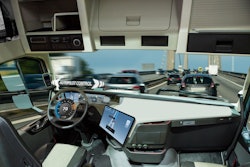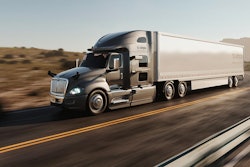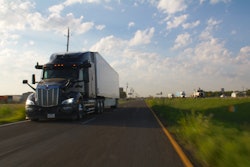While autonomous trucks are typically hailed for their improvements in road safety and delivery times, Torc Robotics executives also say that fuel savings are a big plus.
During a recent interview with CCJ Senior Editor Tom Quimby (see video above), Torc CEO Peter Schmidt and Torc Chief Strategy Officer Andrew Culhane touched on a variety of topics about their self-driving Freightliners, including fuel savings that can reach as high as 10%.
“An autonomous truck doesn’t care about hours of service or gets nervous or needs a rest. You can run it super smoothly, so while it runs you can save a lot of fuel – up to 10% we do envision,” said Schmidt.
[Related: Questions about autonomous vehicles]
Getting to that big fuel savings comes from working with a machine that will more readily accept and follow orders for throttling back on fuel consumption.
“An easy example is our vehicles can be more patient if the fleet operator decides, given time of day, they want to operate at 58 miles an hour rather than 65,” Culhane said. “We know that has fuel economy today, but it's something that's very hard to get a human driver to do today because they want to move with the flow of traffic or they always want to be optimizing for hours of service.
“So being able to have another ability to optimize these assets, through whether it's telling [the truck] to drive slightly slower, whether that's through mission control having great insights on future traffic and being able to launch in time, again much like air traffic control might time the flow of that asset through an area,” Culhane continued.
[Related: 'Boring' test drive in Torc Robotics autonomous truck]
Self-driving truck developer Plus, which markets highly automated driving and full autonomous systems, also reports a 10% fuel economy gain.
“Commercial pilots and customer deployments have shown that our PlusDrive driver-in, highly automated driving solution provides at least 10% fuel savings and reduced carbon emissions,” said Plus co-founder and Chief Operating Officer Shawn Kerrigan.
“One way that our autonomy technology can reduce fuel usage is by continuously optimizing braking and throttling in all road gradients, curvature and traffic conditions, including stop-and-go traffic,” Kerrigan continued. “Most importantly, these are real, not hypothetical savings for fleets from a commercial product that is available today with PlusDrive. PlusDrive can up-level the entire truck fleet to drive like the most fuel-efficient drivers.”
North American Council for Freight Efficiency Executive Director Mike Roeth pointed out that while autonomous truck fuel gains can be impressive, results are dependent on base line comparisons. For example, from NACFE’s work with autonomous truck developers, fuel savings can reach “as much as 10 but likely 5% because fleets are already utilizing cruise control and other technologies in the base OEM offerings,” Roeth said.
Contents of this video
00:00 - How are autonomous trucks safe?
01:08 - Mission Control
01:41 - Benefits of autonomous trucks including fuel savings and more
03:06 - Autonomous truck release date?
03:35 - How you can check out Torc's technology
Video transcript
Dr. Peter V. Schmidt (00:02):
In the first 10, 15 minutes, people are super excited to see that such big truck, big rig is moving autonomously, driving through dense urban traffic, doing maneuvers, lane changes, mergers all of this. And then the most interesting thing is, so after 10, 15 minutes, it gets boring. Most people are a little bit disappointed, but we always say it's boring by design. It should be boring because that means it's safe.
Andrew Culhane (00:30):
One of the things we always look at when we design these systems, we design these trucks, is to ensure that we have a level of both redundancy but also detection of any potential issues. If we potentially lose a sensor for example, not only does the system detect it and continue to operate safely, we utilize what we call minimum risk conditions or minimum risk maneuvers that allow us to understand what is that safe next step to take for the truck. That varies depending on the issue, and that could be everything from a sensor to a steering motor, and what do you do at that point in time. So we have an amazing team that dives in on those and figures out what is that appropriate safe behavior to take to that next step.
Dr. Peter V. Schmidt (01:07):
The autonomous truck won't work without mission control.
Andrew Culhane (01:10):
Mission control can always provide that routing guidance, that high level input pretty similar to a dispatcher and driver manager.
Dr. Peter V. Schmidt (01:16):
They're checking is the entire route safe to drive, always checking what's the health status of the truck, of the software. It's really needed, especially to operate a fleet of autonomous trucks versus a single autonomous truck.
Andrew Culhane (01:28):
But ultimately it's up to the autonomous truck to make its own call as to when it's appropriate to stop, get off an exit. Mission control can provide that guidance much like again, a driver manager may do today, but the truck is responsible as it goes down the road.
(01:43):
Some of the unique benefits that aren't maybe as obvious at first with self-driving technology, one of the most important ones that we found is really around the predictability of elements of a supply chain. So with mining, we see that with autonomous haul trucks and the predictability that you get going from the pit up to a crusher and how that has a positive effect on the overall network. That's something we fully expect here with freight networks as well. The more predictable that middle mile, that long haul piece can get through self-driving technology, the better we can optimize that overall network and one of those huge benefits that we see coming from self-driving technology.
Dr. Peter V. Schmidt (02:17):
An autonomous truck doesn't care about hours of service or gets nervous or doesn't need rest. You can run it super smoothly. So while it runs, you can save a lot of fuel up to 10%, we do envision.
Andrew Culhane (02:30):
An easy example is our vehicles can be more patient if the fleet operator decides given time of day, they want to operate it 58 miles an hour rather than 65. We know that has fuel economy today, but it's something that's very hard to get a human driver to do today because they want to move with the flow of traffic or they always want to be optimizing for hours of service. So being able to have another ability to optimize these assets, through whether it's telling it to drive slightly slower, whether that's through mission control having great insights on future traffic and being able to launch in time, again much like air traffic control might time that flow of that asset through an area.
Dr. Peter V. Schmidt (03:10):
The bar is more or less, we call it exemplary driver. It's a driver, it is never tired, never distracted, never texting, never over speeding. That's the bar that we want to reach and once we have reached and can also prove it consistently, then we think it's safe to release the product. We firmly believe that our factory build solution is absolutely superior to any bought on solution.
CCJ Senior Editor Tom Quimby (03:35):
So if a fleet's interested then in getting inside one of the trucks here, can they go ahead and do that? Just reach out to Torc?
Dr. Peter V. Schmidt (03:42):
Yeah, of course. Reach out to Torc and we will make it happen. We are proud to show off our technology.













